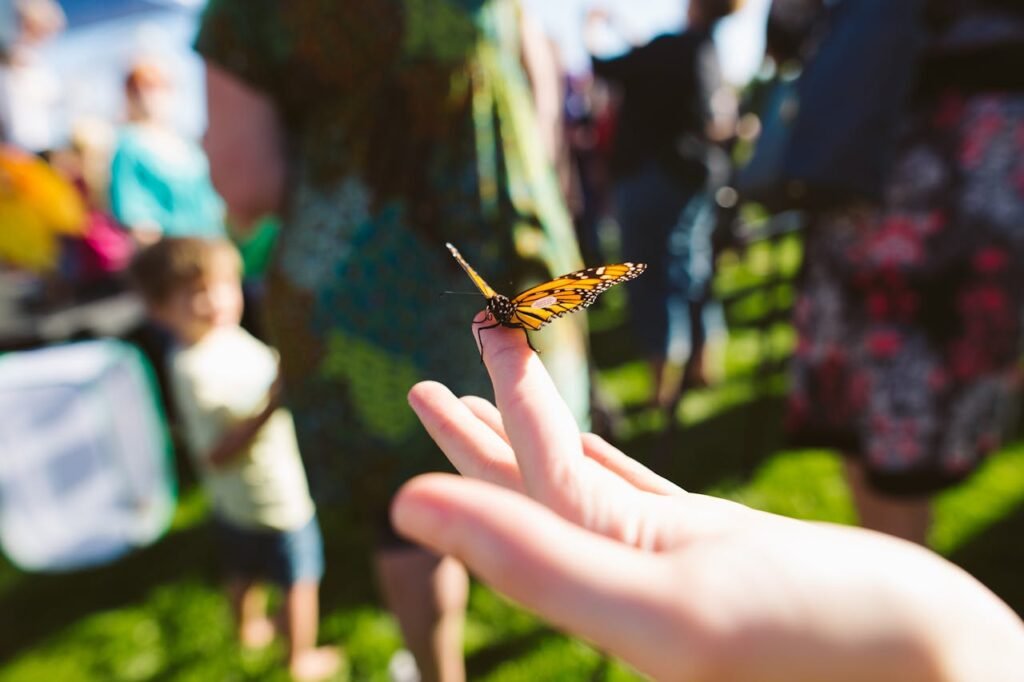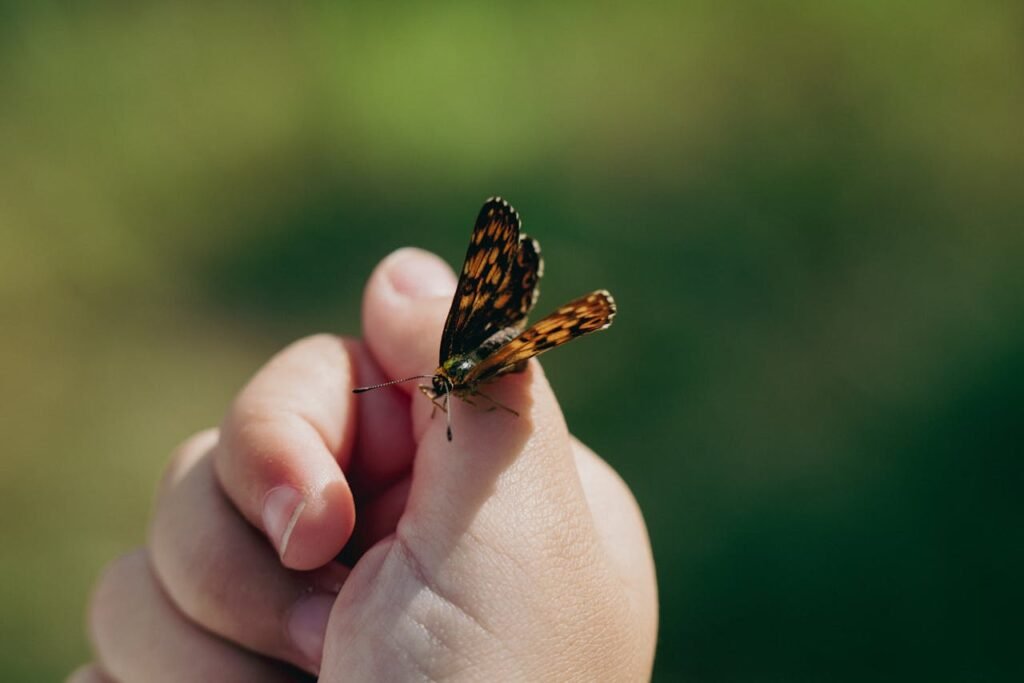What It Usually Means When a Butterfly Lands on You, and What the Science Says
Most of the time, a butterfly that lands on a person is not delivering a message from the spirit world; it’s looking for a resource. Butterflies feed mainly on nectar, which gives them sugars for energy, but nectar is poor in certain salts and amino acids they need. To get those missing nutrients, many species practice a behaviour scientists call “puddling”: gathering at damp ground, dung, rotting fruit, or even human sweat to sip mineral-rich fluids. According to a 2025 scientific review of puddling behaviour, butterflies use mineral-rich sources to obtain sodium and nitrogen that are scarce in a nectar-only diet.
A classic field study backs this up with real numbers. In a survey of tropical butterflies, researchers recorded hundreds of individuals and dozens of species visiting moist or mineral-rich baits; the counts were highest at farmland sites where nutrients were more exposed. “With one single exception, all attracted butterflies were males,” the study reported, showing how common puddling is among male butterflies. These males likely use the sodium they drink to bolster their reproductive success. According to a 1999 study by Beck et al., researchers recorded 227 individuals (46 species) at a rainforest site and 534 individuals (54 species) at a farmland site.
Other experiments go further: when male butterflies take in extra sodium, they court harder and enjoy greater mating success. A laboratory and field study published in 2016 found that males that consumed sodium-rich sources courted more vigorously and achieved higher mating rates than males that did not. That helps explain why male butterflies are often the ones you see “taste-testing” a sweaty hand. According to the study, sodium intake can directly affect male mating success.

What Stories, Experts and Real Encounters Tell Us
People often describe butterfly landings as magical moments — and many of those are real, verifiable events reported in newspapers, museum feeds, and social media. A bride in Massachusetts told reporters that a monarch landed on her and her family at meaningful times, and she now sees monarchs as reminders of her late father; she said, “At exactly noon, the time in which he had passed, a monarch butterfly landed on each of us.” That moment was reported in People magazine and captured broadly on video and social media. A number of other high-profile and local news stories show similar, moving encounters during weddings, performances, and visits to butterfly expositions.
Scientists and butterfly-house staff offer straightforward, non-mystical explanations for many of these events. Curators at natural history museums and butterfly houses explain that bright lights, stage makeup or sweat, and the mineral traces on skin can attract butterflies. For example, when a performer had a butterfly land on her face mid-performance, a Smithsonian curator told Time reporters that the insect was likely drawn to the salt in sweat under bright stage lights. That expert explanation matches decades of field work on puddling and mineral-seeking behaviour.
Yet the fact that science explains the why does not erase the very real emotional power of the moment. People often interpret these encounters as signs, comfort, or a pause that reconnects them to nature. Reported real-life cases — from museum visitors who pause breathless with a butterfly on their palm to viral wedding clips — are useful evidence of how the same natural behaviour does double duty as cultural meaning for humans. News outlets and museum staff document both sides: the ecological reason and the emotional response.
Cultural and Emotional Meanings
Cultures around the world have long used butterflies as symbols: transformation, renewal, and the presence of the dead are common themes. Those associations come from real human practices — weddings, memorial rituals, and literature — not from any supernatural ability of the insect. Modern journalists and human-interest stories repeatedly show how people attach deep personal meaning to butterfly landings. For instance, multiple verified wedding reports and human-interest pieces recount butterflies landing on participants during releases or ceremonies; those moments are then interpreted as signs of memory, blessing, or connection. The reporting is straightforward: the butterfly landed, people felt something powerful, and they told the story to journalists.
Scientists caution us to separate symbolic meaning from biological cause. A review of puddling behaviour makes clear that the driver is nutrient acquisition; yet it also notes that context — such as butterflies being common at a butterfly house or during mass releases — raises the odds that one may land on a person by chance or because the person provides a mineral source.
Biology explains the action, and culture explains what people feel about the action. Both are real and useful. According to studies, puddling is driven by the butterflies’ need for minerals such as sodium and nitrogen.

If a Butterfly Lands on You: Friendly, Practical Advice
If a butterfly lands on you, here are safe, simple steps that respect the insect and keep the moment special.
If you want to keep the moment gentle, remain still. Butterflies land carefully and will usually fly off when they’ve had enough. If you move suddenly, you can hurt the insect. This is why staff at butterfly houses always say, “watch, don’t touch.” Many museums and exhibits post that same guidance.
Remember that the butterfly probably wants salts or moisture. If you are sweaty, the insect is sampling your sweat for sodium; if you are wearing floral perfume or have residual sugary residue on your skin, that can be attractive too. Avoid touching or rubbing the butterfly’s wings; butterfly scales are delicate and can be rubbed off easily. The science of wing structure and behaviour shows wings are living, sensitive surfaces that butterflies protect by behaving calmly and choosing shaded landing spots.
If you are worried about allergies or insects on skin, gently blow on the insect or wait for it to move on — most butterflies will leave quickly once they have had their fill. Do not try to forcefully remove a butterfly by grabbing it; instead, cup your hand with the palm up and let it walk onto your finger, or tilt your hand so it can fly away on its own. If you are at an event that releases butterflies, follow the organisers’ instructions — releases are planned so the insects can settle without harm. News reports from wedding releases show organisers and guests frequently experience butterflies landing on clothing and hands; staff usually advise the same calm approach.
Finally, if the moment moves you emotionally, that response is real and worth honouring. Science explains the behaviour; culture explains the feeling. You can hold both: appreciate the natural reason the insect chose your skin, and also appreciate whatever meaning the moment has for you. Many people in published stories said the landing became a comforting memory — a perfectly natural event that carried personal significance.
Conclusion: Quick recap
A butterfly landing on you is almost always explained by natural behaviour — puddling and mineral-seeking — especially among male butterflies that need sodium. Researchers have documented puddling in the wild and demonstrated biological effects on mating performance. Real people frequently report powerful emotional reactions to these encounters, and journalists and museum staff document both the biology and the personal meaning. If it happens to you, stay calm, don’t touch the wings, and let the butterfly leave on its own.







